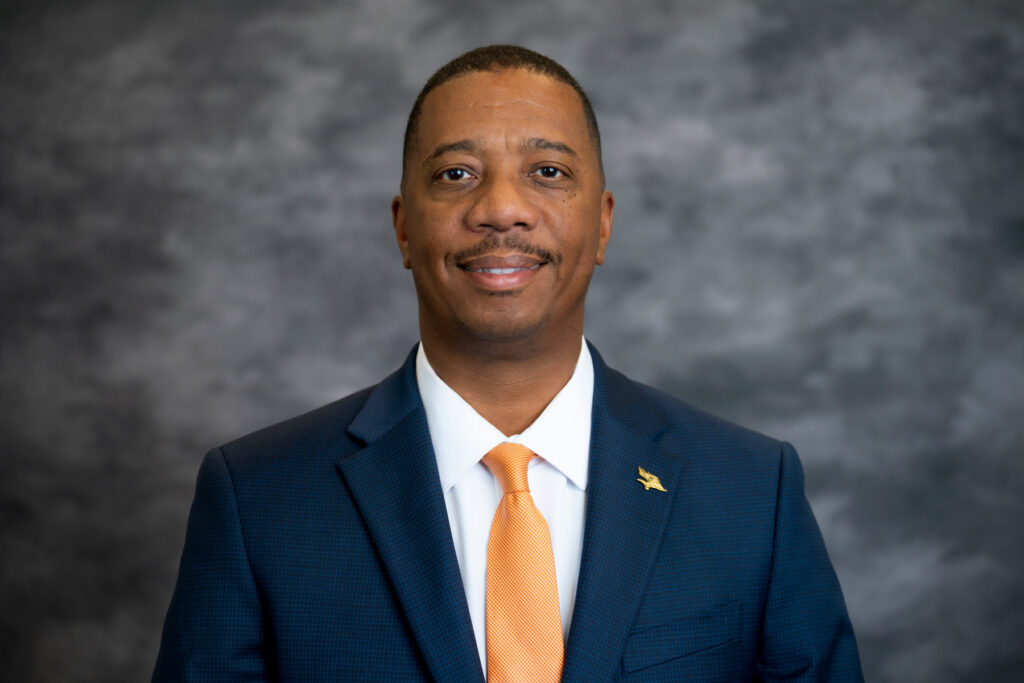
In his State of the State address, Newsom juxtaposed clips of his meetings with National Guard members charged with intercepting illegal drugs to contrast with Republican efforts to quash immigration reform.
Credit: YouTube / Office of the Governor
Gov. Gavin Newsom sharply contrasted California with red-state America during a pre-recorded State of the State address Tuesday, warning ominously that the state’s values and status as “a beacon of hope” are “under assault.”
“Forces are threatening the very foundation of California’s success — our pluralism, our innovative spirit, and our diversity,” he said. To underscore his claim, he liberally juxtaposed images during his 28-minute speech: Florida Gov. Ron DeSantis signing a ban on abortion with Newsom embracing an LGBTQ marcher at a Pride rally; headlines of congressional Republicans rejecting bipartisan immigration reform with National Guard members whom Newsom deployed to the border to intercept fentanyl.
The partisan, politically charged talk came two days before the first debate between President Joe Biden and former President Donald Trump and five months before a national election that Newsom called “another extraordinary moment in history.” Newsom, who has assumed the informal role as an articulate surrogate for Biden, underscored the importance of the president’s re-election for Californians.
“For generations, we’ve stood for progress: championing women’s rights and LGBTQ rights, protecting the environment, and expanding civil rights,” he said. “Conservatives and delusional California bashers want to roll back social progress, social justice, racial justice, economic justice, clean air, clean water and basic fundamental fairness.”
Primarily, though, Newsom’s talk both defended and lauded the “California way” and his administration’s accomplishments — in enhancing innovation and job creation, stopping drugs at the border, lowering crime, expanding environmental protections and providing shelter for the homeless.
He pointed to the elimination of 9,300 unsafe homeless encampments while turning former hotels and apartments into 15,300 units of housing and the progress with the Delta conveyance to protect water supplies, the “largest climate resilience project in the nation.” California is driving the electric vehicle industry and new industries to combat climate change, he said.
While critics portray California’s cities as lawless dystopias, the governor said the state’s violent crime rate has dropped to half of its peak in 1992; California has a lower homicide rate than 29 other states, including Florida and Texas, he said. He attributed California’s gun safety laws as a cause and asserted that 140,000 more Americans would be alive if the nation had California’s homicide rate.
Newsom devoted little of the address to education but pointed to the expansion of after-school and summer programs for low-income schools and the creation of community schools — a $4 billion initiative he protected from possible cuts — as accomplishments. At community schools, he said, students will receive family support, free meals and tutoring.
He also cited the state-funded hiring and training of literacy coaches in high-poverty schools, the creation of universal transitional kindergarten — a new grade for 4-year-olds — and, starting next year, the screening of all young students for possible learning challenges, including dyslexia, while introducing a new, state-funded multi-language screener.
Together, he boasted, these K-12 initiatives comprise “some of the most transformative policies in our state’s history, and most significant in our nation.”
In a vague reference to the state’s efforts to thwart censorship of social studies textbooks and novels from school libraries by conservative school boards, Newsom said California has acted “to protect a student’s right to learn, and a teacher’s right to teach.”
Diversity in demographics and in thought is California’s strength, he said. “Weird, wild, free-spirited California. A place that can elect Ronald Reagan and Jerry Brown — back to back,” he said.
Through revolutions in farmworker rights, free speech, love, computing and biotechnology, “we are building a state that transforms the world over and over again,” Newsom said.
In a news conference outside the Capitol an hour after the speech was released, Republican leaders laid out a vastly different counter-narrative.
“We have crime out of control, inflation out of control,” said state Sen. Brian Dahle, R-Bieber. “$24 billion for homeless, and we’ve actually increased homelessness. For the first time in the state’s history, we’ve deployed CHP (California Highway Patrol) to Oakland, San Francisco and Bakersfield to combat crime.”
“Republicans in California have not controlled a statewide office or the Legislature for decades, so (Gavin Newsom) needs to look in the mirror and understand that he’s running the state into the ground,” Dahle said.
Assembly Republican Leader James Gallagher, R-Yuba City, called Newsom “unhinged” for diverting attention from his own performance by attacking Republicans in Congress.
“Let me tell you what the state of the state is right now. It’s a husband and wife sitting around that kitchen table, head in hands, trying to figure out how to pay the bills,” Gallagher said. “It’s parents who are afraid to send their kids to the local park because they’re afraid they might be attacked because it’s human devastation on our streets in every city. People lost in homelessness.
“And the problem has only gotten worse since Gavin Newsom has been governor,” he said.
Newsom had planned to give the State of the State address in March but delayed it while awaiting the outcome of Proposition 1 on the March primary ballot, which he had championed. The initiative, which passed narrowly, channeled $6.4 billion to assist Californians facing chronic homelessness and mental health or drug abuse problems.





